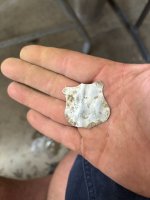Charl
Silver Member
An important new pre-Clovis site identified in Idaho, with points from the Western Stemmed Tradition....
https://www.nationalgeographic.com/culture/2019/08/coopers-landing-idaho-site-americas-oldest/
https://www.pbs.org/wgbh/nova/article/coopers-ferry-first-americans/
https://www.youtube.com/channel/UCOKT_MOwHJ9FDCXv2cepFxQ
16,000-Year-Old Stone Artifacts Unearthed in Idaho | Archaeology | Sci-News.com
https://www.sciencemag.org/news/201...a-ancient-tools-unearthed-idaho-river-suggest
"The findings do more than add a few centuries to the timeline of people in the Americas. They also shore up a new picture of how humans first arrived, by showing that people lived at Cooper’s Ferry more than 1 millennium before melting glaciers opened an ice-free corridor through Canada about 14,800 years ago. That implies the first people in the Americas must have come by sea, moving rapidly down the Pacific coast and up rivers. The dates from Cooper’s Ferry “fit really nicely with the [coastal] model that we’re increasingly getting a consensus on from genetics and archaeology,” says Jennifer Raff, a geneticist at the University of Kansas in Lawrence who studies the peopling of the Americas."
https://www.nationalgeographic.com/culture/2019/08/coopers-landing-idaho-site-americas-oldest/
https://www.pbs.org/wgbh/nova/article/coopers-ferry-first-americans/
https://www.youtube.com/channel/UCOKT_MOwHJ9FDCXv2cepFxQ
16,000-Year-Old Stone Artifacts Unearthed in Idaho | Archaeology | Sci-News.com
https://www.sciencemag.org/news/201...a-ancient-tools-unearthed-idaho-river-suggest
"The findings do more than add a few centuries to the timeline of people in the Americas. They also shore up a new picture of how humans first arrived, by showing that people lived at Cooper’s Ferry more than 1 millennium before melting glaciers opened an ice-free corridor through Canada about 14,800 years ago. That implies the first people in the Americas must have come by sea, moving rapidly down the Pacific coast and up rivers. The dates from Cooper’s Ferry “fit really nicely with the [coastal] model that we’re increasingly getting a consensus on from genetics and archaeology,” says Jennifer Raff, a geneticist at the University of Kansas in Lawrence who studies the peopling of the Americas."
Upvote
0




